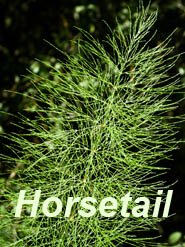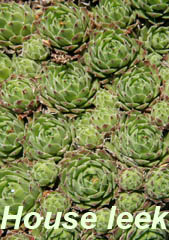The Herb Garden
The Joy of Growing and Using Herbs
Horsetail and House Leeks
by Rachel McLeod
Horsetail (Equisetum arvense and spp) is one of the plants that has lived on the planet Earth far longer than humankind. There were giant and small horsetails growing in enormous quantities in the Carboniferous period and large amounts of the plant formed the coal seams we have depended on for fuel. Equisetum has no close relatives in the plant kingdom; in fact, it is more like the ferns than the flowering plants.
 Like ferns, horsetail has two generations; in the early spring pale pink, fleshy stems appear in damp meadows, each terminating in a small egg-shaped cone that bears the spores. Later, after dropping their spores, these completely disappear and in their place, by about June, the green vegetative stems appear, looking like miniature Christmas trees. It is this part of the plant which is used as a herb and should be collected early in the season and dried. Like ferns, horsetail has two generations; in the early spring pale pink, fleshy stems appear in damp meadows, each terminating in a small egg-shaped cone that bears the spores. Later, after dropping their spores, these completely disappear and in their place, by about June, the green vegetative stems appear, looking like miniature Christmas trees. It is this part of the plant which is used as a herb and should be collected early in the season and dried.
Although horsetail has been used as a herb for a very long time, a warning should be given that the plant is listed by the Department of Agriculture as a poisonous weed. There have been reports that it has a toxic effect on horses; although they will avoid grazing on it in the meadow, the danger is if it gets dried in the hay. Although it is not toxic to humans, it should be taken in frequent small doses and not over a prolonged period of time. It is an excellent source of silicon and many other minerals and, in fact, has been described as one of the most powerful remineralizing agents available.
It is valuable to herbalists as a diuretic and to deal with other problems connected with the kidneys and the urinary system, as well as a vulnerary for internal and external healing. It is useful to have the dried herb on hand at home. A solution is made from horsetail plant mashed up and mixed with warm vinegar (approximately a cup of the horsetail to a cup of vinegar) simmered for about 20 minutes, then cooled and strained. The mixture can be stored in the refrigerator. When it is to be applied to a wound it should be mixed with milk – one part horsetail solution to two parts milk.
I first read about this remedy in an article about a farmer who had had great success with injuries on the farm – to a calf, a filly, and herself! I can add our own experience to that, as horsetail helped the successful and fast healing of a widespread skin rash on my German shepherd. As well as its medicinal uses, horsetail and its relative the scouring rush (Equisetum hyemale) were used in the past to give wood, ivory, silver, pewter, and brass a fine finish. The high silicon content in the stems acts as a gentle but effective polish. Bunches of the rush were used to scour milking pails or scrubbing pots in the kitchen. Even now, it could be very useful to campers.
Finally, it has been proven useful as a spray against mildew on plants, possibly even strengthening their tissues. The mixture recommended is a cup of horsetail plants to a gallon of water. Boil for 20 minutes, strain and use when it has cooled.
Horsetail is best collected from the wild. It is not a plant to introduce into the garden as it spreads uncontrollably in suitable conditions. The scouring rush is less invasive and might make a nice clump beside a pond.
A very different plant that thrives on dry conditions is the house leek (Sempervivum tectorum), more usually known here as hens and chickens because of the way it reproduces vegetatively...the mother “hen” is surrounded by small replicas of itself attached by thin stems. In time, it will make a big mound and the babies can be separated to plant elsewhere at any time. It is very useful to fill in ugly spots in a garden.
Surprisingly, it has been used as a herb for hundreds of years. The fat, succulent leaves can be crushed and applied as a cold poultice to relieve headaches and migraines. They can be cut and used to give relief from itchy bites and stings and also used as an application to remove corns and warts.
In the past, the plant was known for its protective powers against evil, particularly fire and lightening. The Emperor Charlemagne ordered it to be planted on the roofs of all his subject’s houses to give them protection. It would grow well on thatched roofs and between the interstices of slate and other roofs which gave it the name house leek in Britain and parts of Europe. It may still be seen growing on the roofs of old cottages in parts of England and Wales. Often, the owners of the homes resent any removal of the plant, believing it protects them and ensures their prosperity.
Rachel McLeod founded Kiln Farm Herb Garden in Puslinch, Ontario in 1974. This article was published in Natural Life Magazine in 1997.
|

